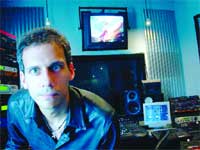
Compositions' Steven Gold, who uses Logic Audio for music recording, has worked on a number of Robert Smigel cartoons, including TV Funhouse.
|
Each time an audio post sound designer, effects editor, Foley artist or mixer approaches an animation assignment they are faced with a blank slate. Background noise doesn't need to be lowered and mistakes don't need to be fixed. Instead, every sound needs to be created, animated and then edited to fit the picture. It's an exciting challenge, to be sure, yet one that also offers unparalleled demands on creativity.
That's not even taking into consideration the vast variety of animation projects that are being produced these days - commercials, sitcoms, promo spots - in a bevy of styles. Consider the difference between an animated show like Dr. Katz wherein sound is more subdued and conventional versus an over-the-top show such as Celebrity Deathmatch that features a variety of brutal acts with sounds to fit each one.
What makes it a bit easier for post houses, though, is it seems that no special gear is required to work on animation projects. Rather, the usual gear such as Digidesign Pro Tools, Logic Audio, and your standard synthesizers and samplers dot studio equipment lists.
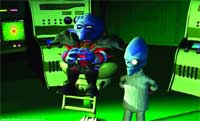
The animated Nickelodeon program Butt Ugly Martians (B.U.M.) is an audio collaboration between several post houses. Screenmusic Studios in Studio City, CA, and Salami Studios in North Hollywood have provided recording services for the show, which is produced by Mike Young Productions in LA and animated using project:messiah 1.5 by DCDC in Hong Kong. Sound recording over the first two seasons was handled by engineer Gordon Suffield, second engineer Lisa Carlon and dialogue editor Chris Eaton of Screenmusic, and by Dan Cubert and Devon Bowman of Salami. Rick Hinson of Salami served as supervising sound designer. B.U.M. is mixed at Optical Image in Worchestershire, England, by Neil Hillman, who also provides additional sound design.
|
Project: Television shows Ace Lightning and Henry's World.
Challenge: Recording engineer Robert Di Gioia, who works on Stage 6 at Toronto-based Tattersall Casablanca (www.tattersallcasablanca. com), does a bit of everything - mixing, ADR, Foley and editing. He regularly works on two shows: Ace Lightning, which is a combination of animation and live action that is a co-production with Alliance Atlantis and the BBC UK; the other is a children's program called Henry's World. This is also a co-production with Alliance Atlantis and a UK-based company called TV-Loonland.
Di Gioia handles all of the recording for Ace Lightning and one of the challenges he finds is the vocal dynamics with some of the characters. "One minute they are whispering very quietly and the next minute they could be screaming at you," he reports. "As you're recording this you have to try to grab it all without going for too many retakes." Another challenge Di Gioia faces is consistency from one episode to the next." If an actor hasn't been in for a few weeks I might play them a bit of their previous episode just so they can hear themselves again."
Solution: While that continuity starts with the actor, Di Gioia says, it continues with him. "My recording chain has not changed throughout this entire season. It's the same microphone, same preamp, same recording medium."
Tools: Di Gioia uses a Neumann U-87A microphone, an Amek 9098 mic preamp and he records into Pro Tools 48K 16-bit. "I record it totally flat, no EQ, no compression. There again, you're eliminating any possible variables," he explains. "Our rule of thumb within the facility for recording dialogue and ADR is record it totally flat, rather than locking someone else into a decision that you have made, which may not be the right one once it gets mixed in with all the other elements."
Tip: "Be very, very organized," he says. So far, he's recorded 26 episodes of both Ace Lightning and Henry's World and he has found that carefully naming Pro Tools files helps. "Usually I name each character, then give it a number for the episode that it's a part of, just in case things get mixed up. It's important to have your files organized that way. And back everything up religiously!"
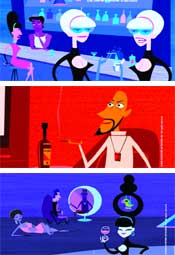
Film Roman's challenge on these promos for Showtime's Night Out on Sho Too was the assortment of characters and their different vocal identities.
|
Project: Four promos for Showtime's upcoming series Night Out.
 |
Challenge: "There were so many characters within one spot and they all had really different vocal sounds," says sound designer/editor Giovanni Moscardino of North Hollywood's Film Roman (www.filmroman.com). "Some were full screen in the front, some might have been back, but the one back might have had a softer sound than the full screen. It was interesting to mix this piece because it wasn't just general setting levels and making it work with the music - there was cross dialogue and there was a lot of tonal qualities." Time constraints were another problem Moscardino faced. "That's pretty normal, but those times changed even when it got to post," he recalls. "Normally in animation you record the dialogue, you edit a final assembly, it's animated to that, and that time pretty much stays. In this case, there were time changes during post, so I had to compress some things, I had to pitch shift, I had to time expand certain characters just to make it all fit, because they didn't want to drop any lines of dialogue. So, if you were fitting it within 28 seconds, you had to do whatever. The problem is you couldn't lose sync with the animation, which is different from live action. Once live action is there, it's there. In animation you can pull up certain pauses and you could do little tricks and vary the rhythm of the piece, but you still have to keep in sync with what's already animated."
Solution: "I used almost the same general EQ on every character, which is not something I would normally do," he says. "I'd also try to get a good balance to make sure that it all cut [together], so I wouldn't have to do too many dips in the music. I could keep the piece energetic and moving." To solve the second issue, Moscardino played with the rhythm of each individual character. "Some of them I had to time compress, some of them I had to time expand and some I did some pitch shifting. At one point we were 12 frames off and had to literally pull 12 frames out of picture to make the dialogue fit within the given time. My solution was to keep everything clear without having too much crossover in dialogue but take out one frame here and one frame there so it wouldn't affect the sync too much. It would start giving me some time because they wanted to add a title card at the end, but I still had to keep all those lines in there. I used a lot of upper frequencies on the EQing because I just wanted to get this dialogue to really cut, because[the] voices were really different."
Tools: "I still use [Avid] AudioVision," he reports. "I use Pro Tools as well, but AudioVision is a much faster editor for post." Moscardino prefers AudioVision's file management, clip editor and its ability to do some minor picture editing. He also uses a Yamaha O3D digital console and found the Milano ISDN box especially handy for ADR sessions.
Tip: "In animation you have so much more freedom than you do in live action, so my tip would be to not be afraid to be creative and stretch the limits of your imagination," he offers. "In live action a car or a dog is going to be a car or a dog. You don't have that much flexibility in that, but in animation if you really let yourself be creative you're going to come up with something unique instead of just using the standard cartoon-y sound effects. When you're dealing with development and new things in animation stay as organized with your media as you can, because things always come back, and they always change."
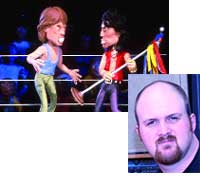
For Celebrity Deathmatch, Sync Sound's Jay Bowen has to create aural environments both inside and outside of the ring.
|
Project: A variety of Robert Smigel animated shorts.
Challenge: The team at bi-coastal Compositions (www.compositions-inc.com) has worked on Robert Smigel cartoons that have run on Saturday Night Live and Comedy Central, including "TV Funhouse," "The Ambiguously Gay Duo" and "X-Presidents."
According to Compositions owner Steven Gold, Smigel's style is to parody old cartoon styles. "So, for the animation they have to copy the style, the way that they draw, the movement of the cartoons and the way the backgrounds look," he explains. "Audio-wise we have to match those old cartoons, too, and since we're parodying we have to match the style almost exactly without infringing on any copyrights."
Solution: "A lot of times they had big orchestras working on those old cartoons, so we have to use samplers and put them through processing to make them sound like they have that warbling effect," Gold explains. "Sometimes we would also add dirt or hiss and rumble. We used this old plug-in that's not available anymore called Vinyl made by Opcode. You can compress with an old over-the-top compressor and change the bandwidth, so there's not a lot of highs and lows. You can close the wave of the bandwidth, you can add hiss, warp, scratches, obviously record pops if that were appropriate and the warble effect."
Tools: "We use Logic Audio to do all our music recording," Gold says. "I like that better than Pro Tools, because it has a better MIDI interface and we use a lot of MIDI with samplers and orchestral sounds that have to be triggered with MIDI as opposed to recorded straight to the box." Compositions also boasts a Mackie Digital 8Bus console along with a handful of samplers and vintage synths, such as Wurlitzer and Rhodes. Rack synths include Trident, Roland 2080s, Kurzweil K2000 and Alesis DM Pro for drum sounds.
Tip: Gold's first tip is to pay close attention to the style of animation that's being worked on, "but when you're doing the score you have to be careful not to distract from the visual," he offers. "In regular cartoon scoring, the composer has to be able to hit as many movements as possible with as many different instrumentations to keep it exciting, and yet keep it a piece of music and not a bunch of sound effects-y music hits. It's got to be musical."
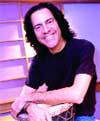
Beat Street's Joe Franco says good integration between music and sound design is required for animated projects.
|
Project: Disney Channel's Stanley.
Challenge: Manhattan's Pomann Sound (www.pomannsound.com) is responsible for everything from sound design to music on this animated show, which is handled by composer Stewart Kollmorgan.
"The whole show is very animal based and a challenge is combining real animal sounds with the talking animal parts. The big challenge is getting them done every week," owner Bob Pomann says with a laugh. "We've got to knock 'em out in five, six days. There aren't really a lot of breaks, maybe two or three breaks throughout the whole 26 weeks. For Stewart it's even more; he doesn't just re-use the music, he scores everything. So, it's not like he's taking stock music and just plugging it in. Stewart's music tracks tell the story without getting in the way of everything else." Another challenge the Pomann Sound crew faces is when the lead character Stanley travels into a dream world to learn how to solve a problem he's facing.
Solution: They need to make sure everything balances when Stanley goes into his dream world, Pomann says. "We do a lot of Foley work where we make sure all the footsteps are there," he says, "and though it is an animated series we don't use stock stuff and we treat everything like it is a film."
Tools: Pomann, who owns one DSP Media Postation, had been planning to purchase more of the company's products until they closed down. Fairlight has purchased DSP's technology and he's waiting to see what they come up with. "I like editing systems that are made for us, for post sound people," he says. "Pro Tools is a good system, but I find that when you need to do stuff really fast and when you've got agency sessions and you have to do everything in front of people, you need a system that's going to work the fastest for you and not crash.

Pomann Sound handles all of the audio for Disney Channel's Stanley, using sound to tell the story without getting in the way.
|
Tip: "Tell the story through the sounds," he says. "Find the perfect footstep, find the perfect door open. With animation - more so than when we work on movies - nothing is there. You have to go for good ambiences to make sure you feel like you're in the place where they're at and it's adding the weight to the picture. You've just got to catch every little sound and nuance, and even if it's not mixed up high, it subconsciously does something. When someone listens to a good track they shouldn't even know they are listening to it. It should feel like it's part of the picture. Sound should be telling the story and not getting in the way."
Project: Full post and music for Between the Lions.
Challenge: This show is a PBS series that is basically a grown-up Sesame Street, explains owner Beat Street's owner Joe Franco. "The whole aim of the show is to teach literacy." Beat Street (www.beatstreetnyc.com) has been working on the show for three years, composing music for the first two, but this past year it picked up the full post responsibilities. "It's a lot more fun because we're involved in the whole process," Franco says. The challenge NYC's Beat Street faces is putting the whole show together, from recording and conforming the voiceovers to spotting the show with sound design elements, Foley and music to performing the final mix and laying it back to Digi Beta.
Solution: In addition to having the experience to get the job done right, Franco has built a small but strong staff. "We have a sound designer/mixer and then we have a music engineer who mixes the music," he explains. "So, it's kind of like two engineers, one who is in charge of the music and one who is in charge of sound design. It's a fairly small operation, but that kind of makes it cool."
Tools: Franco uses Pro Tools along with Sample Cell, although all of the music recorded for the show is real. He's also recently discovered Sound Miner, which has made searching for sound effects a snap. "You type a word in and there it is," he says. "We work with Sound Ideas and Hollywood Edge and your typical libraries. This has made a lot of the obvious sound effects easy to get to. I'd say on about two-thirds of it we'll use sound effects or combine them with things and about one third is Foley.

Cartoon Network is home to a number of shows, including Dexter's Lab, which is audio posted at Hacienda Post; Grim & Evil has its audio serviced at Glenwood Editorial and Glenwood Place Studios; and Powerpuff Girls (pictured) which is sound edited by Joel Valentine at Twenty-First Century Entertainment, Inc. Hacienda Post handles the re-recording and mix.
|
Tip: It's important to "have great integration between the music and sound design, because those are two main elements in your animation," he says. "It's based on the voiceover, that's the most important thing we have here. I've worked on projects where things are fighting here or fighting there and it gets to post and we can't feature everything. So, you try to make everyone happy and then everything sounds small. You can really do a better mix on an animation segment if your music and sound effects people are in sync."
Project: MTV's Celebrity Deathmatch
Challenge: "The specific challenge of designing the sound for a show like this is dealing with the huge variety of settings and styles that I'm confronted with," says Sync Sound (www.syncsound.com) sound designer John Bowen, who has been working on the show for four years. "The initial impression of this show is that you have two people slugging it out in a ring surrounded by crazy fans. If that's all the show was it would be simple to produce and it would be incredibly boring." Over the show's run they have done just about every kind of Celebrity Deathmatch imaginable, such as John Wayne versus Groucho Marx in the style of Marx's show You Bet Your Life and Pee-wee Herman versus George Michael styled after Pee-wee's Playhouse.
Solution: "I rely heavily on the great team of people here," says NYC-based Bowen. "We spend time creating new sounds for each show. When we did the Pee-wee show, I needed to re-create the sounds of Pee-wee's Playhouse. Luckily our sound effects guru worked on the original, so he was able to quickly and accurately identify what I would need."
Tools: I cut Deathmatch on an AMS Neve AudioFile because the editing interface is the most intuitive," Bowen explains. "We average 3,000 sounds per 22 minutes of program, so I can't afford to fool around. I also work on Pro Tools at times. In reality, the tools are the least important part of the picture. What matters is that you are able to contribute, through sound, to the production as a whole."
Tip: "Good sound designers need to know their place in the storytelling process," he says. "When the story is sound driven, work on a deeper level than just covering the details. Sound carries emotional qualities that can manipulate an audience through suggestion and analogy. The real art lies in making choices that serve the story."